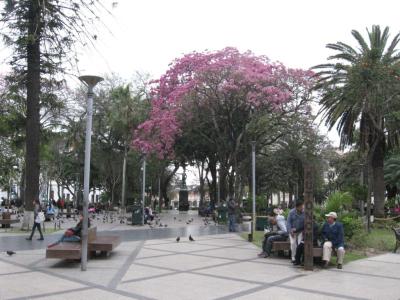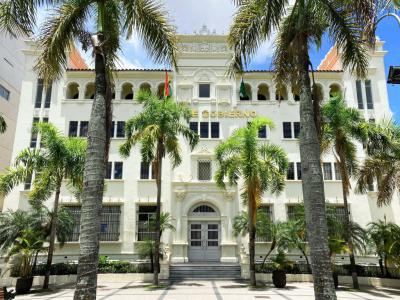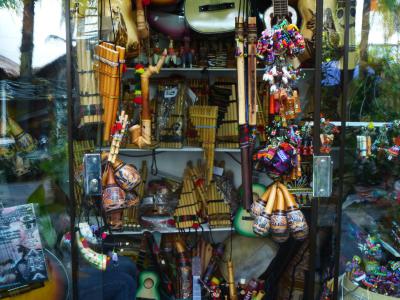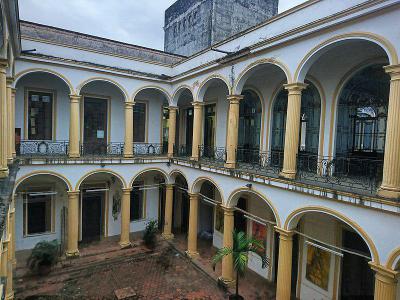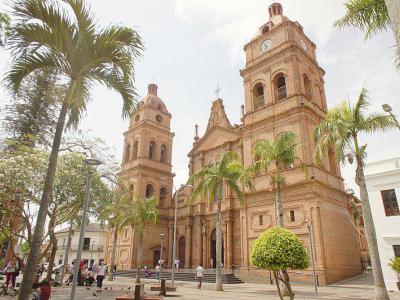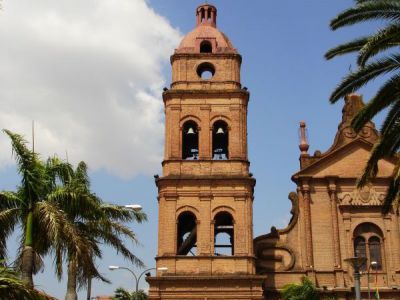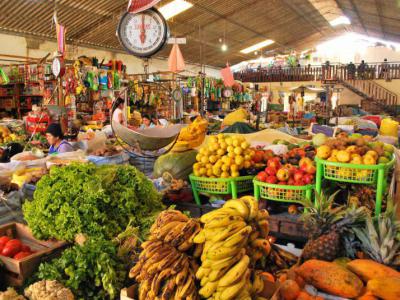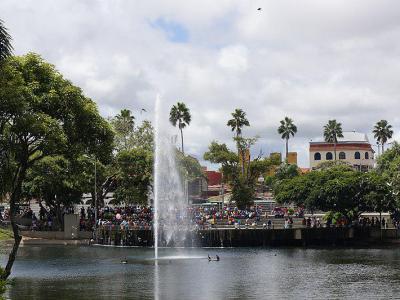Santa Cruz Introduction Walking Tour (Self Guided), Santa Cruz de la Sierra
Santa Cruz de la Sierra ('Holy Cross of the Mountain Range'), commonly known as Santa Cruz, is the largest city in Bolivia. Rooted in the country's eastern lowlands, Santa Cruz emerges as a compelling blend of historical depth and vibrant contemporary culture.
The city was originally founded in 1561 by the Spanish explorer Ñuflo de Chavez, some 200 km (124 miles) east of its current location, and was moved several times until it was finally established on the Pirai River in the late 16th century.
For much of its history, Santa Cruz was mostly a small outpost town, and even after Bolivia gained its independence in 1825 there was little attention from the authorities or the population in general to settle the region. It was not until after the mid-20th century that profound agrarian and land reforms, followed later by natural gas and oil extraction, prompted the city's transformation at a very fast pace.
Central to Santa Cruz's historical narrative is the Old Town area, a charming sector that houses several of the city’s most iconic landmarks. At the heart of it lies the bustling September 24 Square (Plaza 24 de Septiembre), named after the date commemorating Santa Cruz's call for independence from Spanish rule in 1810. This lively plaza is surrounded by a mix of colonial-style buildings and modern establishments, fostering a unique urban charm.
Among them is the Cathedral of Santa Cruz, also known as the Cathedral Basilica of Saint Lawrence, showcasing impressive religious art and architecture, reflecting the city’s deep Catholic influences.
Art enthusiasts will take interest in the Museum of Sacred Art adjacent to the cathedral, housing an exquisite collection of religious artworks and artifacts that date back several centuries. A few steps further away, the bustling energy of New Market (Mercado Nuevo) offers a taste of local life, with vendors selling everything from fresh produce to household items.
To relax and absorb the city’s natural beauty, Arenal Park (Parque El Arenal), with its serene lake and lush greenery, provides a perfect escape from the urban hustle.
If you are drawn to historical sites, artistic treasures, or bustling marketplaces, Santa Cruz offers an array of experiences that can satisfy any curious traveler. Take this self-guided walk around Santa Cruz de la Sierra and prepare yourself for some truly unforgettable memories.
The city was originally founded in 1561 by the Spanish explorer Ñuflo de Chavez, some 200 km (124 miles) east of its current location, and was moved several times until it was finally established on the Pirai River in the late 16th century.
For much of its history, Santa Cruz was mostly a small outpost town, and even after Bolivia gained its independence in 1825 there was little attention from the authorities or the population in general to settle the region. It was not until after the mid-20th century that profound agrarian and land reforms, followed later by natural gas and oil extraction, prompted the city's transformation at a very fast pace.
Central to Santa Cruz's historical narrative is the Old Town area, a charming sector that houses several of the city’s most iconic landmarks. At the heart of it lies the bustling September 24 Square (Plaza 24 de Septiembre), named after the date commemorating Santa Cruz's call for independence from Spanish rule in 1810. This lively plaza is surrounded by a mix of colonial-style buildings and modern establishments, fostering a unique urban charm.
Among them is the Cathedral of Santa Cruz, also known as the Cathedral Basilica of Saint Lawrence, showcasing impressive religious art and architecture, reflecting the city’s deep Catholic influences.
Art enthusiasts will take interest in the Museum of Sacred Art adjacent to the cathedral, housing an exquisite collection of religious artworks and artifacts that date back several centuries. A few steps further away, the bustling energy of New Market (Mercado Nuevo) offers a taste of local life, with vendors selling everything from fresh produce to household items.
To relax and absorb the city’s natural beauty, Arenal Park (Parque El Arenal), with its serene lake and lush greenery, provides a perfect escape from the urban hustle.
If you are drawn to historical sites, artistic treasures, or bustling marketplaces, Santa Cruz offers an array of experiences that can satisfy any curious traveler. Take this self-guided walk around Santa Cruz de la Sierra and prepare yourself for some truly unforgettable memories.
How it works: Download the app "GPSmyCity: Walks in 1K+ Cities" from Apple App Store or Google Play Store to your mobile phone or tablet. The app turns your mobile device into a personal tour guide and its built-in GPS navigation functions guide you from one tour stop to next. The app works offline, so no data plan is needed when traveling abroad.
Santa Cruz Introduction Walking Tour Map
Guide Name: Santa Cruz Introduction Walking Tour
Guide Location: Bolivia » Santa Cruz de la Sierra (See other walking tours in Santa Cruz de la Sierra)
Guide Type: Self-guided Walking Tour (Sightseeing)
# of Attractions: 8
Tour Duration: 1 Hour(s)
Travel Distance: 1.7 Km or 1.1 Miles
Author: DanaOffice
Sight(s) Featured in This Guide:
Guide Location: Bolivia » Santa Cruz de la Sierra (See other walking tours in Santa Cruz de la Sierra)
Guide Type: Self-guided Walking Tour (Sightseeing)
# of Attractions: 8
Tour Duration: 1 Hour(s)
Travel Distance: 1.7 Km or 1.1 Miles
Author: DanaOffice
Sight(s) Featured in This Guide:
- Plaza 24 de Septiembre (September 24 Square)
- Casa de Gobierno (Government House)
- Paseo Artesanal La Recova (La Recova Crafts Market)
- Regional Museum of History
- Catedral de Santa Cruz (Cathedral Basilica of St. Lawrence)
- Museum of Sacred Art
- Mercado Nuevo (New Market)
- Parque El Arenal (Arenal Park)
1) Plaza 24 de Septiembre (September 24 Square) (must see)
September 24 Square, located in the heart of Old Toen, is a central and historically significant square in Santa Cruz. Named after the date marking the uprising of the independence movement in Santa Cruz, the plaza holds deep historical and cultural value. At its center stands a statue of Ignacio Warnes, a local hero who played a pivotal role in the War of Independence, which began in 1810. The plaza is not only a tribute to this key figure but also a site with a darker past, where the head of Warnes was once displayed on a pike as a warning to independentists.
As one of the first urban elements established in the city, September 24 Square has long been a focal point for social and cultural life in Santa Cruz. It serves as a venue for a variety of activities, including artistic performances, social gatherings, and protest demonstrations. The plaza's vibrant atmosphere makes it a popular meeting place for people of all ages and backgrounds, including children, teenagers, and adults. It is common to see older adults enjoying games of chess on the benches, while shoeshiners ply their trade nearby, adding to the square's lively and communal vibe.
The plaza is also noted for its lush vegetation, including palm trees and other native plant species, which provide shade and a serene environment for visitors. The surrounding area is rich with historical architecture, featuring buildings like the Cathedral, the Social Club, and the Municipal Cultural Center. These structures, which retain the colonial architectural style, are not only functional spaces but also important historical landmarks and part of the city's heritage.
As one of the first urban elements established in the city, September 24 Square has long been a focal point for social and cultural life in Santa Cruz. It serves as a venue for a variety of activities, including artistic performances, social gatherings, and protest demonstrations. The plaza's vibrant atmosphere makes it a popular meeting place for people of all ages and backgrounds, including children, teenagers, and adults. It is common to see older adults enjoying games of chess on the benches, while shoeshiners ply their trade nearby, adding to the square's lively and communal vibe.
The plaza is also noted for its lush vegetation, including palm trees and other native plant species, which provide shade and a serene environment for visitors. The surrounding area is rich with historical architecture, featuring buildings like the Cathedral, the Social Club, and the Municipal Cultural Center. These structures, which retain the colonial architectural style, are not only functional spaces but also important historical landmarks and part of the city's heritage.
2) Casa de Gobierno (Government House)
The Government House is a notable landmark with a rich history and significant architectural value. The site originally housed the city's first cinema, "Cine Roma," which opened in 1912 and showcased silent films typical of that era. This cinema was a cultural hub in its time, providing a glimpse into early 20th-century entertainment in Santa Cruz.
Between 1948 and 1950, the Iturralde Levy brothers constructed the current building on this site, adopting a unique blend of Neo-Colonial and Art-Deco styles. This architectural choice was distinctive and somewhat unconventional for Santa Cruz at the time, a city characterized by dusty streets and a lack of basic urban infrastructure. The building's design and construction, utilizing reinforced concrete, marked a significant development in the city's architectural landscape, reflecting a symbolic and monumental ambition.
In 1995, the building was repurposed as the Departmental Prefecture, restoring its urban prestige and reinforcing its symbolic importance in the region. It became known as the Prefectural Palace and served as a central location for departmental governance. Today, it is the headquarters of the Autonomous Departmental Government of Santa Cruz, playing a crucial role in the civic, political, and cultural life of the city.
Between 1948 and 1950, the Iturralde Levy brothers constructed the current building on this site, adopting a unique blend of Neo-Colonial and Art-Deco styles. This architectural choice was distinctive and somewhat unconventional for Santa Cruz at the time, a city characterized by dusty streets and a lack of basic urban infrastructure. The building's design and construction, utilizing reinforced concrete, marked a significant development in the city's architectural landscape, reflecting a symbolic and monumental ambition.
In 1995, the building was repurposed as the Departmental Prefecture, restoring its urban prestige and reinforcing its symbolic importance in the region. It became known as the Prefectural Palace and served as a central location for departmental governance. Today, it is the headquarters of the Autonomous Departmental Government of Santa Cruz, playing a crucial role in the civic, political, and cultural life of the city.
3) Paseo Artesanal La Recova (La Recova Crafts Market)
La Recova Crafts Market is a charming and traditional spot in Santa Cruz. This open-air gallery is an attractive destination for both locals and tourists, offering a glimpse into the region's rich artisan culture. The market is distinguished by its picturesque setup, featuring 51 small houses with thatched roofs, which creates a quaint and inviting atmosphere. These houses are filled with a diverse array of crafts that showcase the traditional artistry of Santa Cruz de la Sierra and other regions of Bolivia.
Visitors to La Recova can find an impressive selection of handcrafted items, including leather goods, wooden sculptures, ceramics, and jewelry made with seeds or precious stones such as bolivianita. The market also offers a variety of ornaments and textiles, each piece reflecting the unique cultural heritage and craftsmanship of the area. This variety makes it a perfect place to find unique souvenirs that capture the essence of Bolivian artistry.
In addition to the crafts, La Recova is also known for its culinary delights. Visitors can enjoy typical pastries, providing a taste of local flavors while browsing the market. The experience is often enhanced by the vibrant sounds of local music, as bands or drummers playing cheerful oriental music sometimes perform, adding to the market's lively and welcoming atmosphere.
Visitors to La Recova can find an impressive selection of handcrafted items, including leather goods, wooden sculptures, ceramics, and jewelry made with seeds or precious stones such as bolivianita. The market also offers a variety of ornaments and textiles, each piece reflecting the unique cultural heritage and craftsmanship of the area. This variety makes it a perfect place to find unique souvenirs that capture the essence of Bolivian artistry.
In addition to the crafts, La Recova is also known for its culinary delights. Visitors can enjoy typical pastries, providing a taste of local flavors while browsing the market. The experience is often enhanced by the vibrant sounds of local music, as bands or drummers playing cheerful oriental music sometimes perform, adding to the market's lively and welcoming atmosphere.
4) Regional Museum of History
The Regional Museum of History is an institution steeped in cultural and historical significance. Housed in a beautifully preserved building that once belonged to a prominent local family, the museum offers a fascinating glimpse into the region's past. The building itself has a storied history, having been appropriated by the government and repurposed for various uses before finally being converted into a museum. Today, it stands as a testament to the architectural heritage of Santa Cruz, providing a fitting backdrop for the rich collections it houses.
The museum features three permanent exhibitions, each offering unique insights into different aspects of the region's history and culture. The first exhibition focuses on the Chiquitano culture, showcasing a variety of documents and photographs that illuminate the way of life of the Guaraní, Ayoreo, Guarayos, Chané, and other indigenous groups. This collection highlights their harmonious relationship with nature and their extensive knowledge of plants, which played a crucial role in their daily lives and spiritual practices.
Another significant exhibition at the museum includes artifacts unearthed during the excavation of the Bolivia-Brazil pipeline. These items provide a tangible connection to the pre-Hispanic cultures that once thrived in the region, offering valuable insights into their craftsmanship, trade, and societal structures.
The museum also houses a specialized library, which contains a wealth of historical documents and resources. While access to the library's collections is restricted and requires permission from the curators, it remains an invaluable resource for researchers and scholars interested in delving deeper into the history of Santa Cruz and the broader Bolivian region.
The museum features three permanent exhibitions, each offering unique insights into different aspects of the region's history and culture. The first exhibition focuses on the Chiquitano culture, showcasing a variety of documents and photographs that illuminate the way of life of the Guaraní, Ayoreo, Guarayos, Chané, and other indigenous groups. This collection highlights their harmonious relationship with nature and their extensive knowledge of plants, which played a crucial role in their daily lives and spiritual practices.
Another significant exhibition at the museum includes artifacts unearthed during the excavation of the Bolivia-Brazil pipeline. These items provide a tangible connection to the pre-Hispanic cultures that once thrived in the region, offering valuable insights into their craftsmanship, trade, and societal structures.
The museum also houses a specialized library, which contains a wealth of historical documents and resources. While access to the library's collections is restricted and requires permission from the curators, it remains an invaluable resource for researchers and scholars interested in delving deeper into the history of Santa Cruz and the broader Bolivian region.
5) Catedral de Santa Cruz (Cathedral Basilica of St. Lawrence) (must see)
The Cathedral Basilica of Saint Lawrence is the principal Catholic church in Santa Cruz de la Sierra. Its history dates back to the colonial era, with the first church established by Mercedarian Fray Diego de Porres during the time of Viceroy Francisco Álvarez de Toledo. The current structure, however, owes much to a significant reconstruction in 1770 led by Bishop Ramán de Herbosos, with sacristan Antonio Lombardo playing a key role in its execution.
In the mid-19th century, under the leadership of Marshal Andrés de Santa Cruz, the old temple was replaced by a new church designed by French architect Felipe Bertres. This new church is noted for its eclectic style, blending various architectural influences, and is particularly renowned for its wooden vaults adorned with intricate pictorial decorations. The use of brick and lime mortar in the construction has contributed to its enduring presence in the city.
The cathedral's main altar is a highlight, featuring parts of the original silverwork from the Jesuit mission of San Pedro de Moxos. This silver coating, along with four high relief sculptures also from the same mission, adds a significant artistic and historical dimension to the church. These elements not only enhance the aesthetic appeal of the cathedral but also serve as a tangible connection to the region's Jesuit heritage, reflecting the deep cultural and religious history of Santa Cruz.
Today, the Catedral de Santa Cruz stands as a central landmark in the city, not only for its architectural beauty and historical significance but also as a vital center of spiritual life for the local community.
In the mid-19th century, under the leadership of Marshal Andrés de Santa Cruz, the old temple was replaced by a new church designed by French architect Felipe Bertres. This new church is noted for its eclectic style, blending various architectural influences, and is particularly renowned for its wooden vaults adorned with intricate pictorial decorations. The use of brick and lime mortar in the construction has contributed to its enduring presence in the city.
The cathedral's main altar is a highlight, featuring parts of the original silverwork from the Jesuit mission of San Pedro de Moxos. This silver coating, along with four high relief sculptures also from the same mission, adds a significant artistic and historical dimension to the church. These elements not only enhance the aesthetic appeal of the cathedral but also serve as a tangible connection to the region's Jesuit heritage, reflecting the deep cultural and religious history of Santa Cruz.
Today, the Catedral de Santa Cruz stands as a central landmark in the city, not only for its architectural beauty and historical significance but also as a vital center of spiritual life for the local community.
6) Museum of Sacred Art (must see)
The Museum of Sacred Art was founded 25 years ago by the priest Monseñor Carlos Gericke Reiche. Situated within the Cathedral Basilica of St. Lawrence, the museum houses an impressive array of religious art and artifacts, providing a rich glimpse into the city's spiritual and cultural heritage. The collection includes religious paintings, sculptures, and relics crafted from gold and silver, some of which date back to the 1600s. These artifacts are not only of artistic value but also serve as a testament to the deep religious traditions and history of the region.
The museum is thoughtfully organized into three sections, each with a distinct focus. The first section, known as the Wood Room, features an extensive collection of wooden sculptures, furniture, and other artifacts, highlighting the craftsmanship and artistic expressions of different periods. This section provides visitors with an appreciation of the intricate work and religious devotion that went into creating these pieces.
The second section of the museum showcases robes embroidered with gold, which date back to the 17th century. These robes, worn by priests, offer a glimpse into the ceremonial aspects of religious life and the importance of liturgical vestments in the church's rituals. The detailed embroidery and use of precious materials reflect the significance of these garments in religious ceremonies.
The final section of the museum is dedicated to gold and silver artifacts, including crowns, candelabras, and shields. This collection highlights the use of precious metals in religious art and objects, underscoring the wealth and devotion invested in ecclesiastical items. The pieces on display not only serve a religious function but also stand as works of art in their own right, showcasing the artistic and cultural achievements of the period.
The museum is thoughtfully organized into three sections, each with a distinct focus. The first section, known as the Wood Room, features an extensive collection of wooden sculptures, furniture, and other artifacts, highlighting the craftsmanship and artistic expressions of different periods. This section provides visitors with an appreciation of the intricate work and religious devotion that went into creating these pieces.
The second section of the museum showcases robes embroidered with gold, which date back to the 17th century. These robes, worn by priests, offer a glimpse into the ceremonial aspects of religious life and the importance of liturgical vestments in the church's rituals. The detailed embroidery and use of precious materials reflect the significance of these garments in religious ceremonies.
The final section of the museum is dedicated to gold and silver artifacts, including crowns, candelabras, and shields. This collection highlights the use of precious metals in religious art and objects, underscoring the wealth and devotion invested in ecclesiastical items. The pieces on display not only serve a religious function but also stand as works of art in their own right, showcasing the artistic and cultural achievements of the period.
7) Mercado Nuevo (New Market)
The New Market, despite its name, is one of the oldest markets in Santa Cruz, and is a vibrant hub of local culture and cuisine. Recently, the market's exterior was transformed with a colorful mural showcasing traditional Bolivian art, making it a distinctive landmark that's hard to miss. Located just three blocks from the city's main plaza, the New Market offers an authentic experience where visitors can enjoy the rich flavors and lively atmosphere of a traditional Latin American market.
The market is particularly known for its array of fresh, delicious, and affordable food options, making it a popular spot for both locals and tourists looking to eat like a local. Among its culinary highlights are the natural juices, which provide a refreshing taste of the region's tropical fruits, and the typical Bolivian menu, which often includes a hearty peanut soup as an appetizer. This soup, known for its rich flavor and nourishing qualities, is a staple in Bolivian cuisine and sets the stage for a satisfying meal.
In addition to these offerings, Mercado Nuevo is famous for its "Mario Liver," a dish that has become a local favorite. This liver scramble is renowned for its flavor and is often recommended for breakfast, offering a hearty start to the day. The market's atmosphere is filled with the vibrant colors and sounds of a bustling Latin market, making it not just a place to eat but also an immersive cultural experience.
The market is particularly known for its array of fresh, delicious, and affordable food options, making it a popular spot for both locals and tourists looking to eat like a local. Among its culinary highlights are the natural juices, which provide a refreshing taste of the region's tropical fruits, and the typical Bolivian menu, which often includes a hearty peanut soup as an appetizer. This soup, known for its rich flavor and nourishing qualities, is a staple in Bolivian cuisine and sets the stage for a satisfying meal.
In addition to these offerings, Mercado Nuevo is famous for its "Mario Liver," a dish that has become a local favorite. This liver scramble is renowned for its flavor and is often recommended for breakfast, offering a hearty start to the day. The market's atmosphere is filled with the vibrant colors and sounds of a bustling Latin market, making it not just a place to eat but also an immersive cultural experience.
8) Parque El Arenal (Arenal Park) (must see)
The Arenal Park is a historic and scenic recreational area located just a few blocks from the main square in Santa Cruz. This park is known for its distinctive lagoon, featuring a small island and surrounded by lush gardens, making it a popular destination for both locals and tourists. Recently, the Municipal Government undertook a project to restore and enhance the park, which had been encroached upon by the expanding commercial area of the nearby Los Pozos market.
Historically, the Arenal lagoon served as a natural pond and a rainwater collector at the edge of the city during the 19th and early 20th centuries. It was a communal space where children swam and fished, women washed clothes, and livestock from nearby provinces were watered. This blend of practical and recreational use made the lagoon a vital part of daily life in Santa Cruz. Over time, as the city expanded, the lagoon was transformed into a more structured park, offering stunning views and leisure activities like pedal-boat rides.
A notable feature of Arenal Park is the impressive bas-relief mural created by the renowned Bolivian artist Lorgio Vaca. This mural intricately depicts various historical and contemporary scenes from Santa Cruz, providing a visual narrative of the city's rich cultural heritage. The park also houses the Folklore Museum, which is set to reopen after renovations. This museum offers insights into the traditional arts, crafts, and customs of the region, further enriching the cultural experience for visitors.
Historically, the Arenal lagoon served as a natural pond and a rainwater collector at the edge of the city during the 19th and early 20th centuries. It was a communal space where children swam and fished, women washed clothes, and livestock from nearby provinces were watered. This blend of practical and recreational use made the lagoon a vital part of daily life in Santa Cruz. Over time, as the city expanded, the lagoon was transformed into a more structured park, offering stunning views and leisure activities like pedal-boat rides.
A notable feature of Arenal Park is the impressive bas-relief mural created by the renowned Bolivian artist Lorgio Vaca. This mural intricately depicts various historical and contemporary scenes from Santa Cruz, providing a visual narrative of the city's rich cultural heritage. The park also houses the Folklore Museum, which is set to reopen after renovations. This museum offers insights into the traditional arts, crafts, and customs of the region, further enriching the cultural experience for visitors.
The Most Popular Cities
/ view all



